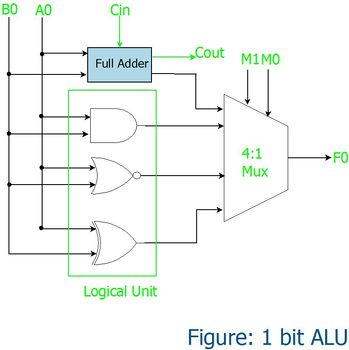Difference between revisions of "ALU in Detail"
| Line 2: | Line 2: | ||
{{box|type=l_green_light|text= You should have heard of an Arithmetic and Logic Unit before, while discussing a Computer CPU or a micro controller. In this tutorial we will look at what an ALU really is? <br /> | {{box|type=l_green_light|text= You should have heard of an Arithmetic and Logic Unit before, while discussing a Computer CPU or a micro controller. In this tutorial we will look at what an ALU really is? <br /> | ||
We will discuss a 4 bit ALU; this would limit many possibilities 16. We would assume that associated registers and instruction set are also 4 bit.<br /> | We will discuss a 4 bit ALU; this would limit many possibilities 16. We would assume that associated registers and instruction set are also 4 bit.<br /> | ||
| + | |||
| + | |||
| + | === The basic Unit: 1 bit ALU=== | ||
| + | |||
| + | [[File:1bitALU.jpg|400x350px|framed]] | ||
| + | We assume you are familiar with logic gates, and also have come across a 1 bit adder. It simple adds two 1 bit inputs as shown below. | ||
| + | |||
| + | }} | ||
{| class="wikitable" style="text-align:center" | {| class="wikitable" style="text-align:center" | ||
|- | |- | ||
| Line 17: | Line 25: | ||
|- | |- | ||
|} | |} | ||
| − | |||
| − | |||
| − | |||
| − | |||
| − | |||
| − | |||
| − | |||
| − | |||
Revision as of 11:58, 8 December 2013
Arithmetic and Logic Unit in Detail
You should have heard of an Arithmetic and Logic Unit before, while discussing a Computer CPU or a micro controller. In this tutorial we will look at what an ALU really is?
We will discuss a 4 bit ALU; this would limit many possibilities 16. We would assume that associated registers and instruction set are also 4 bit.
We will discuss a 4 bit ALU; this would limit many possibilities 16. We would assume that associated registers and instruction set are also 4 bit.
The basic Unit: 1 bit ALU
We assume you are familiar with logic gates, and also have come across a 1 bit adder. It simple adds two 1 bit inputs as shown below.
| Inputs | Outputs | ||
|---|---|---|---|
| A | B | S | C |
| 0 | 0 | 0 | 0 |
| 1 | 0 | 1 | 0 |
| 0 | 1 | 1 | 0 |
| 1 | 1 | 0 | 1 |

